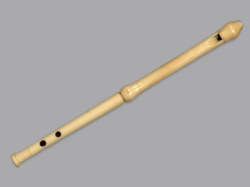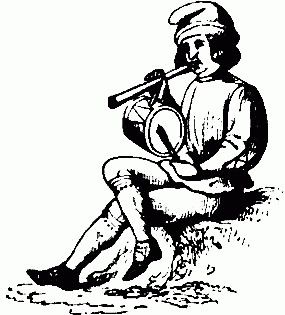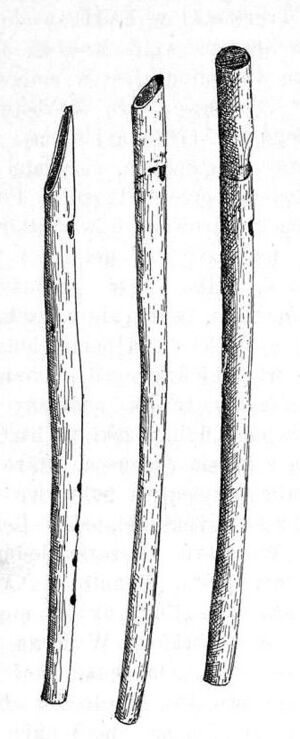Pipe (instrument) facts for kids
 |
|
| Classification | |
|---|---|
| Playing range | |
| 1-2 octaves | |
| Related instruments | |
|
|
A pipe is a type of wind instrument that looks like a tube. The word "pipe" sounds a bit like the instrument itself, like a bird chirping. Many pipes have just a few holes. Players make different sounds by blowing harder, which creates higher notes called harmonics.
Contents
Folk Pipes: Simple and Sweet
Pipes with a special mouthpiece, called fipple flutes, are found in many cultures worldwide. Often, these pipes have six holes. The shepherd's pipe is a common sight in old pictures, showing shepherds playing music. They used pipes to calm their sheep and to entertain themselves.
Today, many six-hole folk pipes are known as the pennywhistle or tin whistle. The recorder is another type of pipe. It is often used to teach music in schools. However, it is also used in professional orchestral music because it is very versatile.
Tabor Pipes: One Hand, Many Sounds
The three-holed pipe is a special kind of folk pipe. It is usually played with one hand. The other hand plays a tabor, which is a small drum. Sometimes, a player might use a bell or a psalterium (a string-drum) instead of a tabor.

In England, this instrument is simply called a pipe. But people often say tabor pipe to tell it apart from other instruments. The tabor pipe has two finger holes and one thumb hole. In England, these three holes play notes like the bottom three holes of a tin whistle. Other tabor pipes, like the French galoubet or the Basque txistu, are tuned differently.
A much larger three-hole pipe is the Slovak fujara. It is typically 150 to 170 cm long. It is made of two connected parallel pipes of different lengths. This is different from the Polish fujara or fujarka, which is a single, smaller pipe. The Polish pipe is usually made of willow bark and is up to 40 cm long. Modern versions of the Polish pipe are also played today. The Czech fujara is similar to both the Slovak and Polish instruments.
The pipe and tabor were a popular musical pair in Asia during the medieval period. They are still popular in some parts of Europe and the Americas. In England, the pipe and tabor became less popular. However, Morris dance musicians helped bring them back in the early 1900s.
Traditionally, pipes were made from cane, bone, ivory, or wood. Today, you can also find pipes made from metal and plastic.
Flageolet: An Orchestral Pipe
The flageolet was created in France. It developed from the tabor pipe and became an instrument used in orchestras. Its bottom three holes were set up like a tabor pipe, with two in front and one in back. A second set of three holes was added above these. The mouthpiece of a flageolet was special, with a sponge inside.
Flageolets were used in orchestras until the 1800s. They were even given keys, just like the orchestral flute, to help play more notes.
Diaulos: Ancient Greek Double Pipe
A diaulos was an ancient Greek wind instrument. It was made of two pipes, called aulos, played together. The two pipes were joined at their base. They were often of different lengths. Sometimes, the musician would use circular breathing to play continuously without stopping for breath.
Reed Pipes: Vibrating Sounds
A reed pipe is built similarly to a fipple flute. However, instead of a whistle mouthpiece, it uses a reed. This is usually a double reed, like the ones found on an oboe. The reed vibrates to make the sound.
Hornpipes: Horn Resonators
Hornpipes are instruments with one or more pipes. They have single reeds that end in a resonator made of horn. Simple hornpipes might just have the reed, the pipe, and the horn. More complex ones can have multiple pipes held together or multiple horn parts. They are found in many places, from India to Spain, including North Africa and most of Europe.
See also
- Bagpipes
- Flute
- Organ
- Panpipes
- Zuffolo
- Pipe and tabor
- Pipers' Guild



